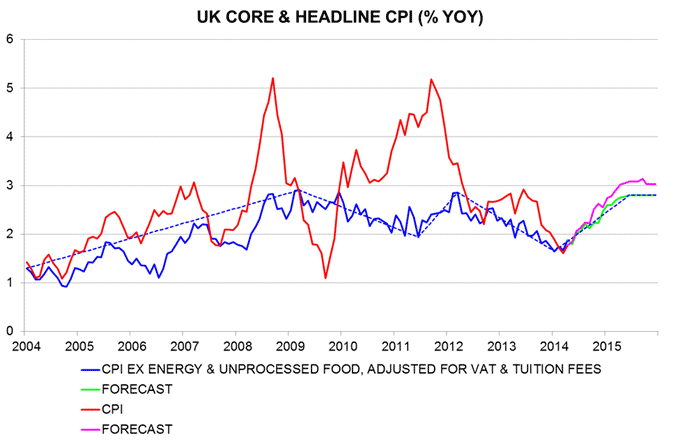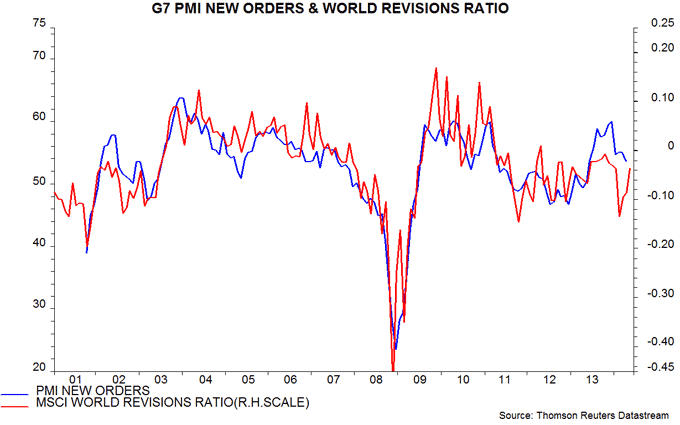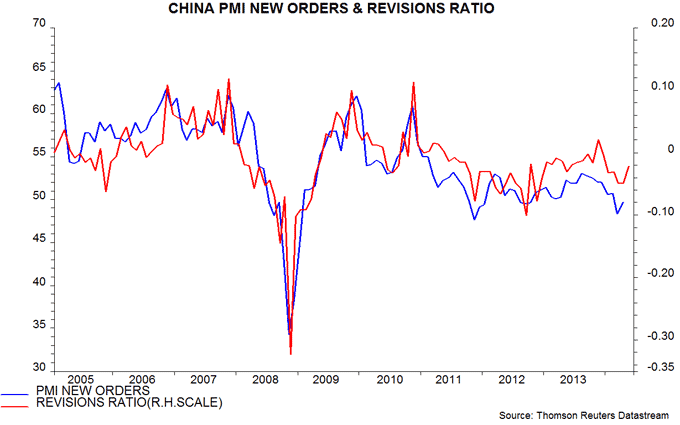Entries from May 18, 2014 - May 24, 2014
Are global investors wrongly positioned?
Global fund managers have raised their cash weighting towards the top of its historical range, according to the May Merrill Lynch survey – see first chart. Defensive positioning would be warranted if monetary policies had tightened and the economic cycle was turning down. The indicators tracked here, however, suggest that monetary conditions have loosened since end-2013 while economic growth is about to pick up.
A turnaround in Chinese economic momentum is signalled by today’s May flash PMI survey conducted by Markit, showing a further rebound in new orders – second chart. This rise is consistent with recent stronger monetary trends – see previous post – and should be confirmed by the official survey released at the start of June. Japanese new orders also recovered this month but Eurozone orders softened*.
Stronger global growth over the remainder of 2014 could be associated with stable to easier monetary policies. The Fed and Bank of England have all but ruled out rate rises this year, while the ECB is certain to cut next month, and China may soon reduce reserve requirements. Firmer currencies should facilitate easing in other emerging economies – Turkey cut rates unexpectedly today. Longer-term bond yields have declined in most markets recently – third chart.
Stocks in cyclical industries should outperform non-cyclicals if global economic conditions strengthen. Cyclicals have lost ground during the growth slowdown between late 2013 and this spring but usually exhibit relative strength after the global longer leading indicator tracked here moves above average, as it has this month – fourth chart*. The Merrill Lynch survey suggests that fund managers are underweight cyclical exposure.
*Manufacturing surveys – the Eurozone services survey strengthened.
**The cyclicals grouping shown includes materials, capital goods, consumer durables and IT. Non-cyclicals include utilities, healthcare and consumer staples.
UK inflation bottoming on schedule
A small move higher in headline and core CPI inflation in April is consistent with the long-standing forecast here of a trend change from down to up in spring 2014 in lagged response to stronger monetary trends in 2012-13.
Posts in August and September last year argued that inflation would fall further in the short term, undershooting the Bank of England’s then forecasts significantly. The decline has been larger than expected, reflecting a stronger exchange rate and weaker global energy and food prices than had been assumed.
The first chart below is an update from the August post showing that major turning points in core inflation over the past decade have followed trend changes in broad money expansion roughly two years earlier, consistent with the Friedmanite rule. The core inflation measure tracked here* was expected to reach a low of 1.9% in late 2013 corresponding to a trough in money growth in late 2011. The decline extended slightly further and longer than expected, to 1.65% in January.
Core inflation, however, returned to 1.9% in April, a five-month high, and the monetarist rule suggests that it will now trend higher through mid-2015. With money growth rising by more in 2012-13 than in the prior 2009-10 upswing, it is reasonable to expect core inflation at least to regain its previous high of 2.8% next year, assuming that the drag from a strengthening exchange rate subsides.
Headline inflation fell for longer and by more than the core rate because of favourable energy and food price trends in late 2013 / early 2014. Global energy and other industrial commodity prices are expected to firm along with economic growth over coming months. Food commodity prices have already recovered significantly, suggesting that CPI food inflation is at or close to a low.
Unprocessed food and motor fuel inflation is assumed to recover to 4% by early 2015, with household energy bills rising at the same rate. Together with the projected strengthening of core trends, this implies that the headline rate will return to 3% next year – second chart.
*The annual rate of change of the CPI excluding energy and unprocessed food, adjusted for the estimated impact of VAT changes and the large rise in undergraduate tuition fees from 2012.


Earnings revisions consistent with economic cycle turn
The forecast that global industrial momentum is reaching a short-term low around now and will rise over the summer implies that PMI new orders indices – a coincident to slightly leading indicator of the cycle – will move higher by mid-year. May flash PMIs are released later this week. The G7 PMI new orders index correlates with the developed markets earnings revisions ratio*, although the latter is more volatile. The ratio rose again this month**, suggesting a coming PMI increase – first chart. This reflected both more earnings upgrades and fewer downgrades.
A PMI*** / revisions ratio correlation is also evident in Chinese data and is similarly hopeful, consistent with recent stronger monetary trends – second chart and previous post.
*The net percentage of equity anaylsts’ company earnings forecasts raised over the last month.
**The ratio is calculated on a mid-month to mid-month basis.
***Official PMI new orders, re-seasonally adjusted.



